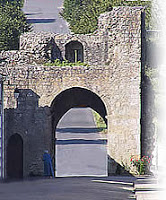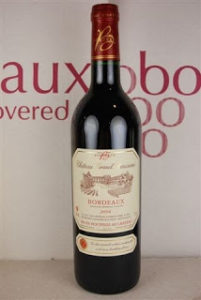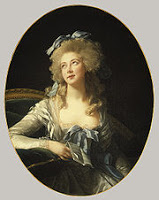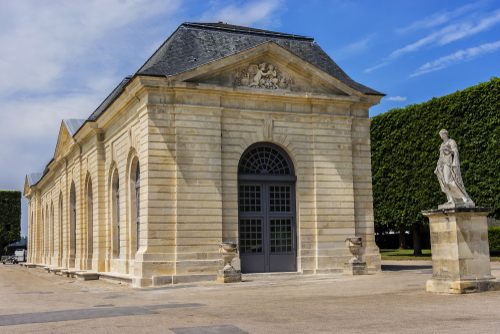Chateau Grand Rousseau lies near Sauveterre de Guyenne in the Entre Deux Mers and is one of several chateaux owned by the renowned Lumeau family who have been wine makers for 4 generations, establishing Vignobles Lumeau in 1840.
Grand Rousseau is a charming deep ruby coloured claret which is a round, smooth, well balanced wine with integrated tannins and a classical bouquet. It has subtle red fruit flavours with notes of blackcurrant, blueberry, tobacco, violets, earth and vanilla.
The Entre Deux Mers is sandwiched between the tidal waters o f the Rivers Dordogne and Garonne and the land is bordered by the vineyards of Saint Emilion in the north and by those of the sweet wines of Sauternes to the south.
f the Rivers Dordogne and Garonne and the land is bordered by the vineyards of Saint Emilion in the north and by those of the sweet wines of Sauternes to the south.
The landscape is softened by limestone valleys, with small hills above crowned with pine or oak and their slopes cultivated with vines.
Sauveterre de Guyenne is a medieval Bastide town and was actually built by the English, in the time of Edward I.
 It still has part of its fortifications with its typical arcaded central square and four gates to the town. The shops radiate out from the centre of town, and it is a pleasure to browse, taking refuge from the midday sun under the age old arches that form the arcades.
It still has part of its fortifications with its typical arcaded central square and four gates to the town. The shops radiate out from the centre of town, and it is a pleasure to browse, taking refuge from the midday sun under the age old arches that form the arcades.
The vineyards of Grand Rousseau cover 275 acres and are 21 miles from Saint Emilion and lie on clay and limestone. The grape varieties planted are 40% Merlot which makes a full bodied and round wine. It ripens early so it is the first variety gathered.
Cabernet Sauvignon makes up 45% of the estate. It brings the wine its structure from tannins but also a delicate and refined flavour profile.
It grows well here but it ripens very slowly, so it is the last variety harvested. It needs years to reach its full maturation. The remainder of vines are 15% Cabernet Franc which makes a supple and fine wine, less colour than the Cabernet Sauvignon but with a more intense bouquet.
Its ageing is more rapid. Grand Rousseau id the result of a skilful combination of these varieties of grapes, with ancestral traditions of wine-making and the techniques of modern oenology.
The 2004 vintage is a blend of 52% Merlot, 32% Cabernet Sauvignon an d 16% Cabernet Franc and is fermented in stainless steel tanks and is thermo-regulated to maintain a constant temperature during the fermentation.
d 16% Cabernet Franc and is fermented in stainless steel tanks and is thermo-regulated to maintain a constant temperature during the fermentation.
This wine will age very well for several years to come and will pair well with roasted fowl, red meat or game and hard cheeses. The recommended temperature of serving is 14 to 16ºC.
This is a super claret to enjoy with your Christmas turkey and Dindes aux Truffes is an old recipe that was a favourite of the epicurean French statesman Charles-Maurice de  Talleyrand-Périgord (1754-1838) – and one time owner of the First Growth Chateau Haut Brion.
Talleyrand-Périgord (1754-1838) – and one time owner of the First Growth Chateau Haut Brion.
Talleyrand employed Mariè-Antoine Câreme, one of the first celebrity chefs who was an early practitioner of haute cuisine. Carême created dishes for Napoléon and also served as chef de cuisine in London to the Prince Regent, later George IV.
He was invited by Tsar Alexander I to come to St. Petersburg, where he lived so briefly he never prepared a meal for the Tsar before returning to Paris, where he was chef to banker James Mayer Rothschild. Talleyrand has another link to Turkey – albeit not a culinary one.
His wife, Catherine Worlée Grand’s child-like beauty did not totally make up for the naivety of her public utterances. She tried to tell someone she was born in India and (instead of “Je suis des Indes”) replied “Je suis d’Inde”, which sounds like “Je suis din de” (I am a turkey).
de” (I am a turkey).
Dindes Aux Truffes
2 1-inch-diameter black truffles
1 16 lb turkey, neck reserved
8 fresh thyme sprigs
4 fresh parsley sprigs
6 bay leaves
12 large shallots, peeled, cut in half
3 cups (or more) chicken stock
½ cup Cognac
3 tbsp flour
3 jars whole roasted peeled chestnuts
2 tablespoons chopped fresh parsley
Coarsely chop 1 ½ truffles; place in a food processor. Add the butter; process mixture until well blended and truffles are finely chopped. Season the truffle butter with salt and pepper. Thinly slice the remaining ½ truffle; cover and chill.

Sprinkle the main cavity of the turkey with salt and pepper. Starting at the neck end, carefully slide hand between skin and breast meat to loosen the skin. Rub the truffle butter, 1 tablespoon at a time, over breast meat under skin.
Rub any truffle butter that remains on your hands all over outside of turkey. Place turkey on small rack set in large roasting pan. Using kitchen string, tie 4 thyme sprigs, 2 parsley sprigs, and 3 bay leaves together.
Repeat with remaining 4 thyme sprigs, 2 parsley sprigs, and 3 bay leaves. Place 1 herb bouquet in the main cavity of turkey and 1 in the neck cavity. Tie legs together loosely to hold shape. Cover turkey with cling film and chill overnight.
Preheat oven to 375°F. Tuck turkey wings under. Place shallots and turke y neck around turkey in the pan. Sprinkle turkey, shallots, and neck with salt and pepper. Roast until turkey and shallots are golden brown. Gently stir shallots.
y neck around turkey in the pan. Sprinkle turkey, shallots, and neck with salt and pepper. Roast until turkey and shallots are golden brown. Gently stir shallots.
Pour 1 cup of stock over the turkey. Roast for 30 minutes. Pour 1 cup of stock over the turkey. Cover turkey breast and legs loosely with foil. Roast for about an hour, basting with pan drippings and adding 1 cup of stock if necessary.
Transfer turkey to platter; tent loosely with foil. Let stand 30 minutes. Using slotted spoon, transfer shallots to bowl. Discard turkey neck.
Pour pan juices into a jug. Spoon off fat from top of pan juices, reserving 6 tablespoons fat. Discard remaining fat. Pour Cognac into roasting pan; place over low heat and bring to boil, scraping up any browned bits.
Add to pan juices. Melt 2 tablespoons reserved t urkey fat in heavy large saucepan over medium-low heat.
urkey fat in heavy large saucepan over medium-low heat.
Add flour and stir 1 minute. Gradually whisk in pan juices. Boil until sauce thickens very slightly, whisking occasionally, about 5 minutes (gravy will be thin). Stir reserved sliced ½ truffle into gravy. Season with salt and pepper. Cover to keep warm.
Melt 4 tablespoons fat in frying pan and add chestnuts and sauté until heated through. Add roasted shallots and chopped parsley; sauté until heated through.
Season with salt and pepper. Surround turkey with chestnut-shallot mixture. Serve with gravy.

